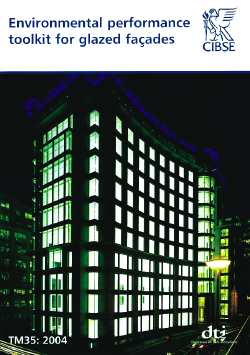Responding to the challenges of glazed façades

An insight into the use of glazed façades on buildings is provided by a new publication and CD-ROM from CIBSE.
Architects like glazed façades on commercial buildings, but how can aesthetics and environmental performance be combined? KAI LIM has the answers.Highly-glazed façades are increasingly used in commercial buildings. However, building designers need to balance the aesthetic qualities that glass provides against the environmental performance of the building envelope. This is because highly glazed buildings tend to increase solar heat gains in the internal spaces. Even though this might be deemed beneficial in the form of passive heating in colder climates, there will often also be an increasing need for cooling throughout the year. The need for a balanced design strategy is further accentuated by the increasing complexity in the design of highly-glazed façades and the growing emphasis on environmental responsibility of buildings, enforced by the 2002 Approved Document Part L2 of the Building Regulations. At present, there is very little consistent data on the overall performance of the building façade, and there is still considerable misunderstanding in the industry as to the critical parameters that influence façade performance. Discussions with architects and designers about advanced façades showed that the performance was looked at purely from the perspective of the glazing, and ignored crucial factors such as frame and edge technologies and the façade design as a whole. The reason is that data readily available to the industry is related to components rather than complete façade systems. Three main environment-related performance criteria are used in façade selection. • U-value • Solar heat gains and solar shading • Condensation
U-value The total thermal transmittance, or U-value, of a glazed façade is one of the most important but most misunderstood concepts in building-envelope design. It determines the thermal-conduction performance of the envelope and indirectly influences the strength of potential cold downdraughts off highly glazed façades during winter. The total thermal transmittance of glazed façades and fenestrations is made up of three components. • Glazing (excluding frame or sash) • Frame or sash • Spacer between panes (in multiple glazing units) More often than not, the U-values quoted by glazing manufacturers tend to be centre-of-pane values only, and care should be taken to consider the combined thermal transmittances of all three components used in a glazed façade system.
Solar heat gains and solar shading Solar heat gain is usually measured as the solar heat gain coefficient (SHGC), or G-Factor, being the fraction of incident irradiance entering glazing and becoming heat gain in the space. The SHGC takes into account both directly transmitted solar heat and absorbed and subsequently re-emitted portion. The shading coefficient (SC) of a type of glass is defined as the ratio of the solar heat gain coefficient of a glazing system to that of a reference pane of clear glass. This shading coefficient constitutes only the direct solar from the Sun, but excludes the radiant temperature effects of the glazing-unit surface due to changes in the glass surface temperatures. The intrinsic solar-shading properties of the glazing unit can be modified and improved in a number of ways. One is through the use of solar films, which are ‘metalised films’ applied to existing glass and cut out up to 82% of the Sun’s total energy, and up to 99% of UV radiation, which reaps additional benefits such as reduced fading. The film can also prevent the shattering of glass. The SC can also be improved by combining solar-control coatings and tinted glass, and using triple glazing. However, in situations where solar heat gain may be beneficial, double-glazing can be combined with high solar gain low-e glass so that heat loss is minimised without sacrificing beneficial input, as may be a disadvantage to triple glazing. The choice of hard rather than soft low-e coating can also help take advantage of solar energy available. Blinds of various sorts can also improve the SC though these will also affect visibility, whereas specialised glass may not.
Condensation Condensation is an important consideration due to the damage moisture and frost can cause, such as rotting of wooden frames, peeling of paint, insulation saturation and mould growth. It occurs on glazed façade surfaces and edges when the surface temperatures are below the dewpoint of the inside air. If the surface temperature is below freezing, frost forms. Condensation can also occur in vented air cavities, which will be a major concern due to the increasing use of this technology. However, if properly controlled, air flow within cavities can actually reduce condensation. Adequate humidity controls in occupied spaces can also be effective in reducing condensation risks. The other main criteria in façade selection are visual comfort for occupants and acoustic performance.
Guidance A new publication and CD-ROM from the Chartered Institution of Building Services Engineers (CIBSE) provides an insight into the use of glazed facades on buildings, particularly regarding their environmental performance. The publication is based on a 2-year DTI Partners in Innovation project. The new publication shows the widely differing performances of different types of facades. The accompanying CD contains an easy-to-use software selector tool, enabling building designers to identify suitable façade systems from a library of 37 glazing systems. The publication is aimed at building designers and anyone with an interest in energy in buildings and how it affected by glazed facades. The toolkit is published in conjunction with the Society of Façade Engineering, a society within CIBSE recently founded to provide a professional body for people involved in the design and technology of building façades and cladding. More details at the web site below.
Kai Lim is principal author of the CIBSE ‘Environmental performance toolkit for glazed facades’ and a member of FaberMaunsell’s Applied Research Group
‘Environmental performance toolkit for glazed facades TM35’ costs £56 (plus VAT and P&P); there are discounts for CIBSE members. It be ordered from CIBSE on tel. 020 8772 3618 or online at www.cibse.org/publications
Related links:
Related articles:








